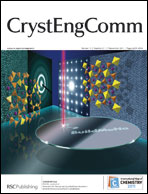Two new luminescent silver–organic frameworks, [Ag2(μ2-bpca)(μ3-PTA)2]n·2nH2O (1) and [Ag4(μ4-pma)(μ2-PTA)2(μ3-PTA)2]n·8nH2O (2), have been easily generated from silver(I) oxide, PTA and aromatic carboxylic acids [biphenyl-4,4′-dicarboxylic (H2bpca) or pyromellitic (H4pma) acid], thus opening up the use of PTA as a versatile N,P-building block in crystal engineering of 3D networks. The topological analysis of 1 reveals a binodal 3,4-connected underlying net with the ins (InS) topology, while 2 represents a tetranodal 3,3,4,4-connected net with a new topology.
You have access to this article
 Please wait while we load your content...
Something went wrong. Try again?
Please wait while we load your content...
Something went wrong. Try again?


 Please wait while we load your content...
Please wait while we load your content...